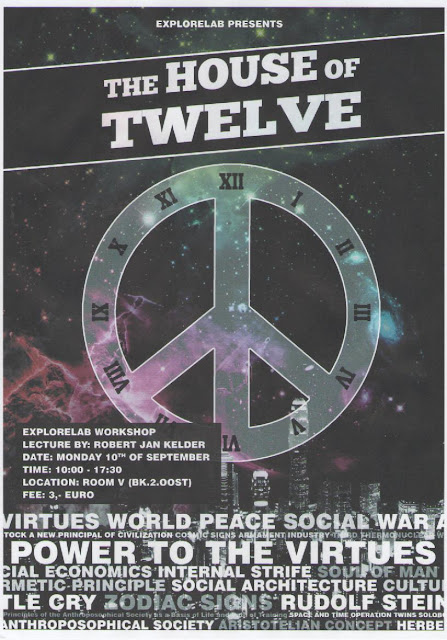Willehalm Institute Press Release/Announcement
Amsterdam, September 6, 2012 - An impromptu meeting at a national meeting of the Occupy movement in The Hague last year between architecture student Philip van der Linden from the Technical University in Delft and Robert Jan Kelder, founding director of the Willehalm Institute Press Foundation in Amsterdam has led to this Explorelab Workshop for students and interested parties .
In this day-long lecture/seminar at the Faculty Building for Architecture in Delft (Julianalaan 134, 2628 BL Delft), Kelder will address, among other things, the questions posed to him by Van der Linden: "What is your vision concerning a possible transition from the current mode of thinking towards a new one. Revolution, war, dialogue, imperative, or perhaps the superiority of a complete (holistic) human being (instead of the view of man as being only a physical creature). How can a young architect, in spite of limitations posed by a world-wide misunderstanding concerning universal values or virtues and "how to become or remain human", contribute as yet to a development in the right direction?"
In the space and time available, the attempt will be made to indicate that a new, holistic way of thinking about man and his place as an individual in society on earth as a social organism has been developed by Rudolf Steiner (1861-1925), the founder of the spiritual humanities known as anthroposophy and the Anthroposophical Society. And furthermore that one of his personal students, the philosopher and industrialist Herbert Witzenmann (1905-1988), has further delineated the solid epistemological basis for this holistic discipline, especially with regard to the idea of social organics as a new principle of civilization capable not only of reforming the world economy, but also of establishing the spiritual framework for "oases of humanity" as starting blocks for a new society.
From his spiritual scientific studies, such as "The Just Price - World Economy as Social Organics", "The Principles of the Anthroposophical Society as a Basis of Life and Path of Training" and "The Virtues - Seasons of the Soul", it can become evident that the same basic living principle of the creation of a golden mean between two polarities can be applied to the inner life of man (virtues) and his outer social-economic life on earth (just prices). Hence it can be said "Just prices are the virtues of the world economy" as an addition to the motto or "battle cry"with which to enter the struggle for world peace through world economy "Power to the Virtues".
Armed with such new insights into the true nature of man and a civilization on earth based on just prices, young architects could play an important role in designing and building a social-aesthetic, earthly environment in which such "oases of humanity" could be housed, prosper and grow. Such "transition towns" could revolve around a central "House of the Twelve", referring not only to the 12 virtues of the month from January "Courage becomes redemptive power" to December "Control of the tongue becomes feeling for truth", but also to the possible 12 world-views from materialism to spiritualism as advanced by Rudolf Steiner in his lecture cycle "Human and Cosmic Thought" given to members of the Anthroposophical Society, who were thought to possess the necessary basic knowledge as a precondition for passing a judgement as to the truth of its spiritual-scientific contents and as a valid means of creating world peace.
From House of Twelve to House of Twenty-three
In these four grandiose, ground-breaking and at first sight even mind-boggling lectures it is developed, however, that there are not only 12 possible world-outlooks with which to view man and the cosmos, but that there are in total 23 ways cosmic conceptions, which all have their justifications: next to the 12 world-views, related to the 12 signs of the zodiac, there are namely 7 psychic moods from occultism to gnosis, related to the seven planets, three "tones" (Theism, Intuitionism and Naturalism) and one last conception called anthropomorphism.
In the third lecture, the following is said: "You see, it is not true to talk in terms of one cosmic conception, but of
12 + 7 = 19 + 3 = 22 + 1 =23
cosmic conceptions which all have their justification. We have twenty-three legitimate names for cosmic conceptions. But all the rest can arise from the fact that the corresponding planets pass through the twelve spiritual signs of the encircling Zodiac. And now try, from what has been explained, to enter into the task confronting Spiritual Science: the task of acting as peacemaker among the various world-outlooks. The way to peace is to realize that the world-outlooks conjointly, in their reciprocal action on one another, can be in a certain sense explained, but that they cannot lead into the inner nature of truth if they remain one-sided. One must experience in oneself the truth-value of the different world-outlooks, in order — if one may say so — to be in agreement with truth."
As can be seen: since the conception of the theme and the poster for this workshop, the idea of The House of Twelve has been enlarged and enhanced to The House 0f Twenty-three!
Now the architectonic task remains of manifesting this idea into concrete design and practical applications using the basic principle of the golden mean between a polarity and the five numbers 23, 12, 7, 3 and 1 as structural building blocks or elements.
This workshop is open for interested parties, however there is limited space; therefore those wishing to attend are asked to please contact Philip van der Linden (06-11711640).

Comments